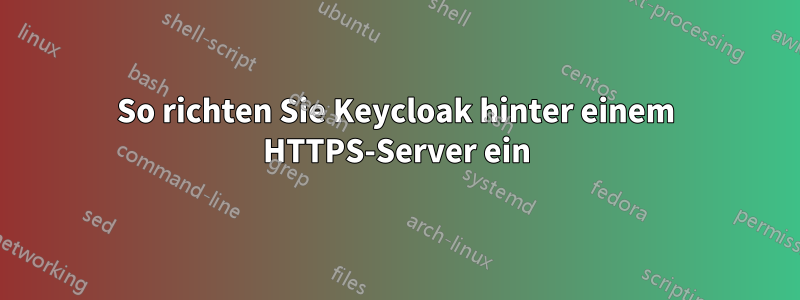
Ich habe das Verfahren hier befolgt https://www.keycloak.org/docs/3.4/server_installation/index.html#enable-https-ssl-with-a-reverse-proxy aber etwas fehlt, wenn ich versuche zu öffnenhttps://auth.solidsense.tk/auth/realms/master/.well-known/openid-configuration Endpunkte haben kein richtiges Schema (http statt https) und ich kann die Administrationskonsole nicht aufrufen
listen 80;
listen [::]:80;
server_name auth.solidsense.tk;
root /var/www/auth.solidsense.tk/html;
index index.html index.htm index.nginx-debian.html;
location /{
proxy_set_header Host $host;
proxy_set_header X-Real-IP $remote_addr;
proxy_set_header X-Forwarded-For $proxy_add_x_forwarded_for;
proxy_set_header X-Forwarded-Proto $scheme;
proxy_set_header Cookie $http_cookie;
proxy_pass http://localhost:9080;
}
listen [::]:443 ssl ipv6only=on; # managed by Certbot
listen 443 ssl; # managed by Certbot
ssl_certificate /etc/letsencrypt/live/auth.solidsense.tk/fullchain.pem; # managed by Certbot
ssl_certificate_key /etc/letsencrypt/live/auth.solidsense.tk/privkey.pem; # managed by Certbot
include /etc/letsencrypt/options-ssl-nginx.conf; # managed by Certbot
ssl_dhparam /etc/letsencrypt/ssl-dhparams.pem; # managed by Certbot
}
root@scw-mainflux:~/keycloak-3.4.3.Final# git diff standalone/configuration/standalone.xml
diff --git a/standalone/configuration/standalone.xml b/standalone/configuration/standalone.xml
index 2cb189a..73db59c 100644
--- a/standalone/configuration/standalone.xml
+++ b/standalone/configuration/standalone.xml
@@ -465,7 +465,7 @@
<subsystem xmlns="urn:jboss:domain:undertow:4.0">
<buffer-cache name="default"/>
<server name="default-server">
- <http-listener name="default" socket-binding="http" redirect-socket="https" enable-http2="true"/>
+ <http-listener name="default" socket-binding="http" proxy-address-forwarding="true" redirect-socket="proxy-https" enable-http2="true"/>
<https-listener name="https" socket-binding="https" security-realm="ApplicationRealm" enable-http2="true"/>
<host name="default-host" alias="localhost">
<location name="/" handler="welcome-content"/>
@@ -564,6 +564,7 @@
<socket-binding name="ajp" port="${jboss.ajp.port:8009}"/>
<socket-binding name="http" port="${jboss.http.port:8080}"/>
<socket-binding name="https" port="${jboss.https.port:8443}"/>
+ <socket-binding name="proxy-https" port="443"/>
<socket-binding name="txn-recovery-environment" port="4712"/>
<socket-binding name="txn-status-manager" port="4713"/>
<outbound-socket-binding name="mail-smtp">
Antwort1
Ich weiß, das ist alt, aber es bleibt unbeantwortet, und wenn man sich die Anzahl der Aufrufe ansieht, kommt das immer wieder vor. Ich gehe davon aus, dass viele, viele Leute irgendwann selbst eine Antwort finden, aber nichts posten, also werde ich posten, was bei mir funktioniert hat.
Typisches Szenario Internet -> HTTPS -> ModSecNginx -> HTTP -> Keycloak
Keycloak 4.4.0 ModSecurity-nginx v1.0.0 (Regeln inline/lokal/remote geladen: 0/903/0)
Ich hatte dasselbe Problem, nachdem ich „alles“ gemacht hatte, Keycloak-Proxy-Forward-True, Nginx-Empfehlungen usw. usw.
curl https://modsec.redacted.com/auth/realms/master/.well-known/openid-configuration
{"issuer":"http://modsec.redacted.com/auth/realms/master","authorization_endpoint":"http://modsec.redacted.com/auth/realms/master/protocol/openid-connect/auth"....
Konfiguration
server
{
listen 80;
listen [::]:80;
location /
{
modsecurity on;
modsecurity_rules '
SecRuleEngine On
SecDebugLog /tmp/modsec_debug.log
# Debug Levels are 3,4,5,9
SecDebugLogLevel 3
# The below rules are disabled, else keycloak does not work at paranoia level 5
SecRuleRemoveById 942432 920273 942421 942420
';
proxy_set_header Host $http_host;
proxy_set_header X-Real-IP $remote_addr;
proxy_set_header X-Forwarded-For $proxy_add_x_forwarded_for;
proxy_set_header Cookie $http_cookie;
proxy_set_header X-Forwarded-Host $host;
proxy_set_header X-Forwarded-Server $host;
proxy_set_header X-Forwarded-Port $server_port;
proxy_set_header X-Forwarded-Proto $scheme;
proxy_pass http://keycloak:8080;
}
}
Das musste ich tun
Ändern:
proxy_set_header X-Forwarded-Proto $scheme;
Zu:
proxy_set_header X-Forwarded-Proto https;
Ergebnis
curl https://modsec.redacted.com/auth/realms/master/.well-known/openid-configuration
{"issuer":"https://modsec.redacted.com:80/auth/realms/master","authorization_endpoint":"https://modsec.redacted.com:80/auth/realms/master/protocol/openid-connect/auth"
Sehen Sie, was passiert ist?
Ändern Sie dann:
proxy_set_header X-Forwarded-Port $server_port;
Zu:
proxy_set_header X-Forwarded-Proto 443;
Oder nehmen Sie es vollständig heraus.
Ergebnis
curl https://modsec.redacted.com/auth/realms/master/.well-known/openid-configuration
{"issuer":"https://modsec.redacted.com/auth/realms/master","authorization_endpoint":"https://modsec.redacted.com/auth/realms/master/protocol/openid-connect/auth",
Ihre Admin-Konsole wird ebenfalls funktionieren. Ich bin überzeugt, dass Nginx die richtigen Variablen dafür hat ($request_scheme oder vielleicht $client_scheme?).
Das ist es!


